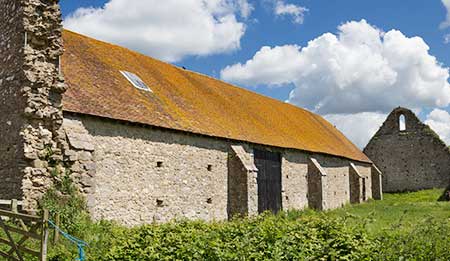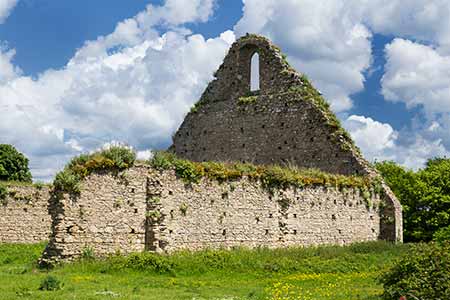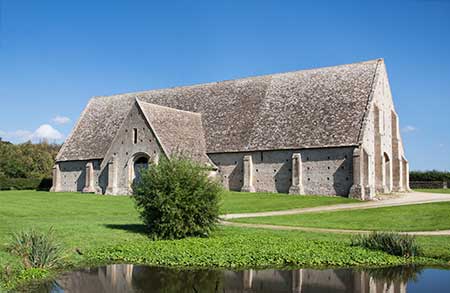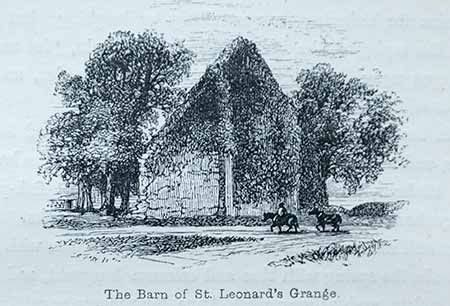St. Leonard's Barn, Hampshire
Saint Leonard's, 6 kilometres (3¾ miles) south-east of Beaulieu, was the site of one of a number of granges associated with Beaulieu Abbey, a network of outlying farms created to generate income and provide food to help support the abbey's Cistercian monks.
(Other relatively nearby granges were at Beufre and Sowley to the south of the abbey, Colbury and Hartford to the north, and Otterwood and Holbury to the east. Relatively distant granges included those located in the Meon valley and Avon valley. All were operated to greater or lesser extent by the monks, assisted by lay-brothers - non-ordained members of the Abbey - and local villagers).
(1) St. Leonard's Barn

Particularly impressive evidence of the monks' farming endeavours can be seen at St. Leonard's where the ruins of an enormous 13th or 14th century barn, with a later, circa 16th century, barn built within, stand by the roadside.
Said to be the largest barn built in medieval England, the St. Leonard's barn was 70 metres (230 feet) long and 33 metres (108 feet) wide, and had a capacity of ½ million cubic feet. Originally a seven bay aisled barn with porches either side of the centre bay, the whole of the east gable end and north wall remain, and so do most of the west gable and the east part of the south wall.

Barns such as this - the Cistercian order alone is reputed have built up to 3,000 - were used to store grain grown locally and also provided workspace for threshing the grain in a lengthy, labour intensive process whereby the crop was spread on the floor and beaten with heavy wooden flails so as to separate the grain from the straw and chaff - the dry, scaly protective casings around the seeds.
The barn, then, would clearly have been an absolute hive of activity in stark contrast to its current, peaceful persona.
(2) St. Leonard's 'sister' barn at Great Coxwell

A somewhat smaller, contemporary barn survives intact, in the care of the National Trust, at Great Coxwell in Oxfordshire, which had been part of the ancient Manor of Faringdon. (Still in magnificent condition, this barn is 46 metres (150 feet) long and 13 metres (44 feet) wide).
An outlying grange belonging to Beaulieu Abbey, Faringdon had originally been intended to be the site of the abbey - King John, the Cistercians' benefactor, granted the lands at Faringdon in 1203, but they instead went on to found their abbey in 1204 at Beaulieu on land also granted by the King.
This barn provides a fascinating insight into how the St. Leonard's barn would probably have looked all those years ago - it served the same purpose, had the same ownership and is of broadly similar vintage: it was until recently considered to be of early 13th century date but scientific testing of its timbers have subsequently suggested that it was under construction in 1292, or shortly afterwards.
(3) The end of active life for St. Leonard's Barn
The Cistercians of Beaulieu Abbey lost their lands in 1538 following Henry VIII's 'Dissolution of the Monasteries' and the abbey and its granges passed into private ownership. Why the barn at St. Leonard's was allowed to fall into ruin is open to conjecture. Maybe it was already in poor condition at this time, or was already disused and ruinous; or maybe it was partially demolished to provide stone and roofing materials for use elsewhere as, indeed, were most of the other Beaulieu monastic buildings.

What seems certain is that a barn of this scale was no longer required by the new owners who commissioned construction of the later barn we now see - this is ½ the width of the original and occupies what were the four western bays, with a structure that makes use of the original north wall and west gable end. East and south walls were constructed afresh, re-using stone from the original building.
John Wise in 'The New Forest - its history and scenery', first published in 1862, included an illustration of the eastern gable - see above - and went on to say: 'Not only do the Abbey grounds but the whole district show the size of the monastery. Going out of Beaulieu, upon the road to Bucklershard (sic) ...... at St. Leonard's, better known now as the Abbey Walls, stands part of the large barn, or spicarium, of the monastery ..... A modern barn now stands within it, partly formed by its walls, but its original size is well shown by the lofty eastern gable, locally called the Pinnacle which, covered with ivy, overhangs the road.'
Not much has changed, then, over the last 160, or so, years, although I've never heard St. Leonard's referred to as Abbey Walls, nor the gable as the Pinnacle!
St. Leonard's Barn is not open to the public, although roadside parking and views are available.
Walkers might be interested to learn, however, that the Solent Way, a 96 kilometre (60 mile) long-distance footpath linking Milford on Sea with Emsworth Harbour, passes along the adjacent road; whilst wildlife enthusiasts might wish to look out for birds, including the occasional little owl, that use the great barn's eastern gable crevices for nesting and roosting.
Furthermore, the track leading to the Needs Ore nature reserve is directly opposite the old barn. Note, though, that access to this reserve is by permit only - available from the National Motor Museum, Beaulieu.
Find out more about St. Leonard's fascinating history
References:
The Beaulieu Cartulary: Edited by S.F. Hockey
An Album of Old Beaulieu: Susan Tomkins
The New Forest - its history and scenery: John Wise
Historic England - St. Leonard's Barn
Historic England - St. Leonard's Chapel
Historic England - St. Leonard's Grange
Quick links
More links
Other related links
Search this site

